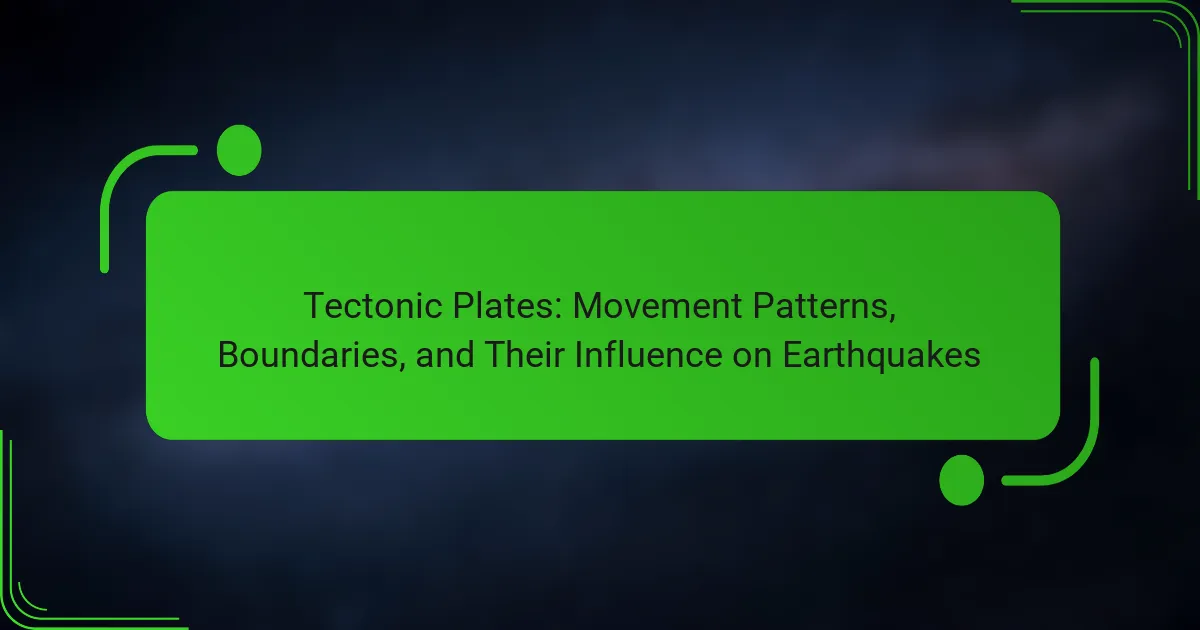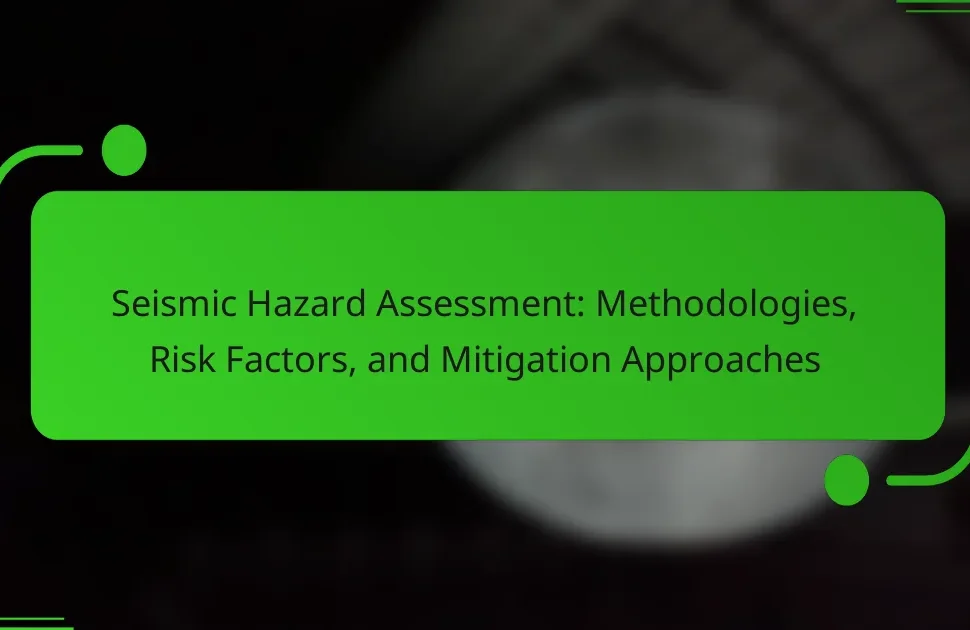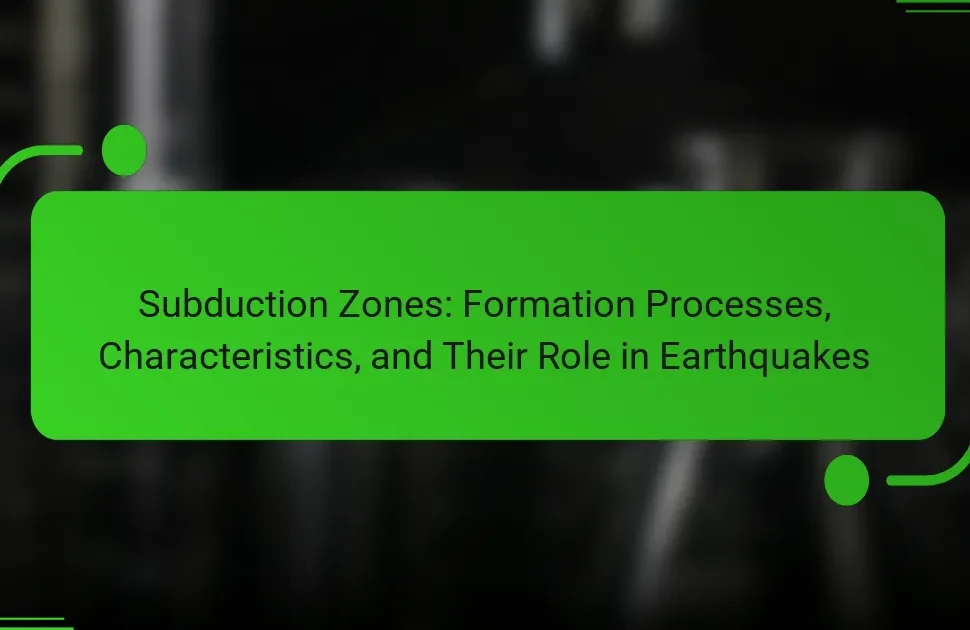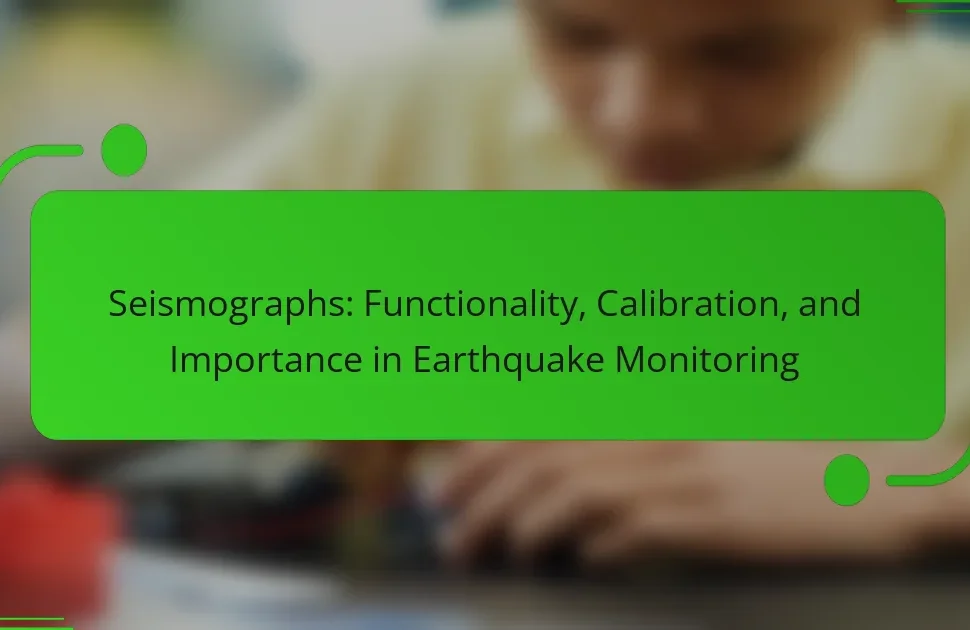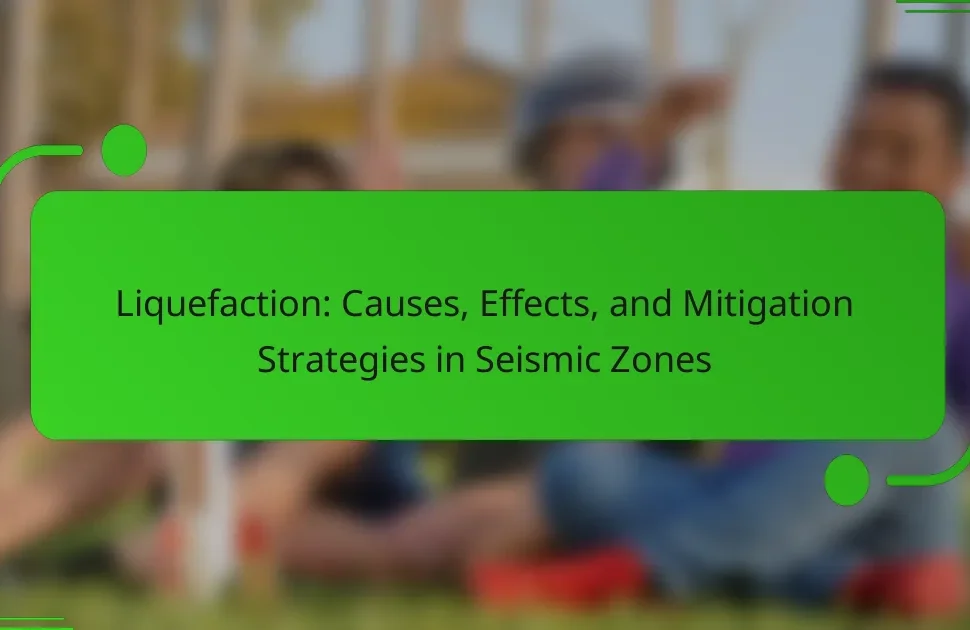Tectonic plates are large sections of the Earth’s lithosphere that float on the semi-fluid asthenosphere and interact with one another through various movements. This article explores the three main types of tectonic plate boundaries: divergent, convergent, and transform, detailing how these interactions lead to geological phenomena such as earthquakes and volcanic activity. The movement of tectonic plates creates stress at their boundaries, which can result in seismic events, particularly in regions like the Pacific Ring of Fire. Understanding the dynamics of tectonic plates is crucial for predicting earthquake risks and informing infrastructure development, as well as for comprehending the formation of mountain ranges and ocean basins.

What are Tectonic Plates?
Tectonic plates are large sections of the Earth’s lithosphere that move and interact with one another. These plates float on the semi-fluid asthenosphere beneath them. Their movement is driven by convection currents in the mantle. There are seven major tectonic plates, including the Pacific Plate and the North American Plate. Tectonic plates can converge, diverge, or slide past each other. The interactions at plate boundaries often result in geological phenomena. Earthquakes frequently occur along these boundaries due to the stress from plate movements. The theory of plate tectonics explains the distribution of earthquakes and volcanic activity globally.
How do Tectonic Plates form and evolve?
Tectonic plates form through the cooling and solidification of molten rock in the Earth’s mantle. As the mantle material rises, it creates new crust at mid-ocean ridges. This process is known as seafloor spreading. Over time, tectonic plates evolve through interactions at their boundaries. These interactions include divergent, convergent, and transform boundaries. At divergent boundaries, plates move apart, allowing magma to rise and form new crust. At convergent boundaries, plates collide, leading to subduction and mountain formation. Transform boundaries involve plates sliding past each other, causing earthquakes. The movement and interaction of tectonic plates are driven by convection currents in the mantle. These currents create a dynamic system that continuously reshapes the Earth’s surface.
What are the different types of Tectonic Plates?
There are three main types of tectonic plates: continental plates, oceanic plates, and transform plates. Continental plates are thicker and less dense than oceanic plates. They primarily consist of granite and form the continents. Oceanic plates are thinner and denser, composed mainly of basalt. They form the ocean floors. Transform plates slide past each other horizontally. This movement can cause earthquakes along fault lines. Each type of plate plays a crucial role in shaping the Earth’s geology and topography.
How do geological processes affect Tectonic Plate formation?
Geological processes significantly influence tectonic plate formation. These processes include mantle convection, subduction, and seafloor spreading. Mantle convection drives the movement of tectonic plates. Hot material from the Earth’s interior rises, while cooler material sinks. This circulation creates forces that contribute to plate movement. Subduction occurs when one plate is forced beneath another. This process recycles crust and contributes to the formation of new crust at divergent boundaries. Seafloor spreading occurs at mid-ocean ridges, where magma rises to create new oceanic crust. These geological processes shape the dynamic nature of tectonic plates and their interactions.
What is the significance of Tectonic Plate movement?
Tectonic plate movement is significant because it shapes the Earth’s surface and influences geological events. This movement causes the formation of mountains, earthquakes, and volcanic activity. For example, the collision of plates can create mountain ranges like the Himalayas. Additionally, the movement along fault lines is responsible for earthquakes, impacting human settlements. The Pacific Plate’s interaction with surrounding plates leads to the Ring of Fire, an area with high volcanic and seismic activity. Understanding these movements is crucial for predicting natural disasters and assessing geological hazards.
How does Tectonic Plate movement influence the Earth’s surface?
Tectonic plate movement significantly influences the Earth’s surface by causing geological phenomena. This movement can lead to the formation of mountains, valleys, and oceanic trenches. For example, when two plates collide, they can create mountain ranges like the Himalayas. Conversely, when plates pull apart, they can form rift valleys, such as the East African Rift. Additionally, tectonic movements are responsible for earthquakes. The sudden release of energy along fault lines results in seismic activity. This activity reshapes the landscape over time. Moreover, volcanic eruptions occur at plate boundaries, adding new material to the surface. The movement of tectonic plates continuously alters Earth’s geology.
What are the driving forces behind Tectonic Plate movement?
Tectonic plate movement is primarily driven by convection currents in the Earth’s mantle. These currents result from the heat generated by the Earth’s core. As hot mantle material rises, it cools and then sinks back down, creating a cycle. This movement exerts forces on the tectonic plates above. Additionally, slab pull occurs when a denser oceanic plate sinks into the mantle at subduction zones. This process pulls the rest of the plate along with it. Ridge push is another force, occurring at mid-ocean ridges where new material is added, pushing plates apart. Together, these mechanisms explain the dynamic nature of tectonic plates.
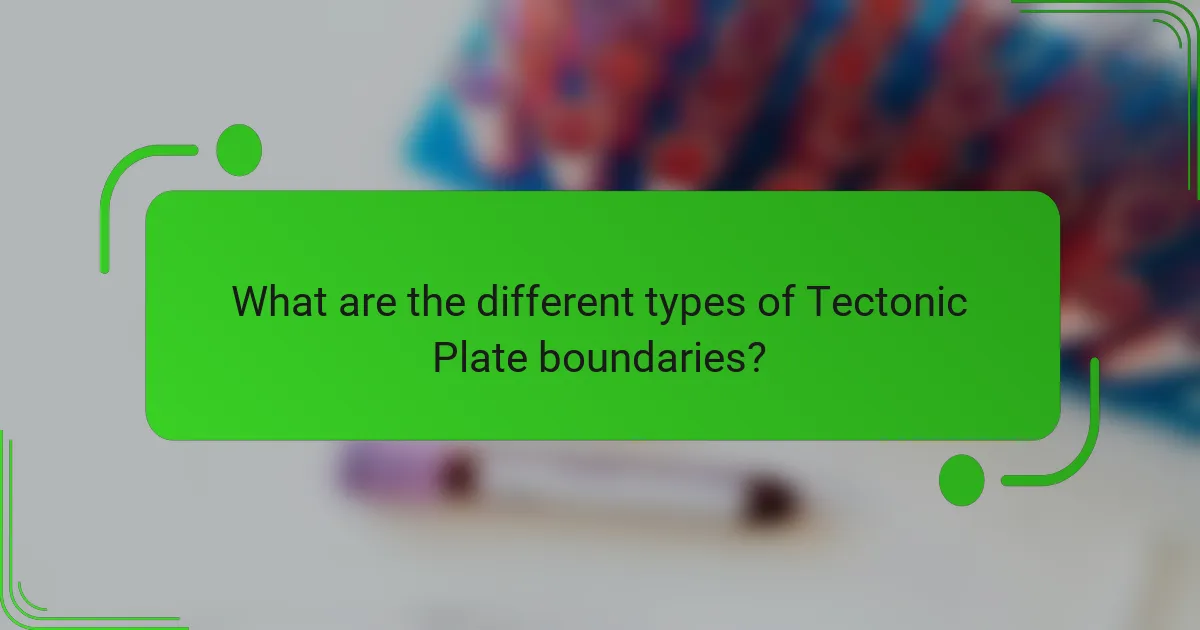
What are the different types of Tectonic Plate boundaries?
The different types of tectonic plate boundaries are divergent, convergent, and transform boundaries. Divergent boundaries occur where plates move apart. This movement creates new crust as magma rises to the surface, forming mid-ocean ridges. Convergent boundaries happen when plates collide. This collision can lead to subduction, where one plate is forced under another, creating mountain ranges or volcanic activity. Transform boundaries occur when plates slide past one another. This lateral movement can cause earthquakes along fault lines. Each type of boundary plays a significant role in geological processes on Earth.
How do divergent boundaries operate?
Divergent boundaries operate where tectonic plates move apart from each other. This movement creates new crust as magma rises to the surface. The process occurs primarily at mid-ocean ridges. As plates separate, earthquakes can occur due to the stress of the moving plates. The formation of rift valleys is another result of divergent boundaries. An example of this is the East African Rift. Divergent boundaries are crucial for the recycling of Earth’s crust. They also play a role in volcanic activity, contributing to the formation of new landforms.
What geological features are associated with divergent boundaries?
Divergent boundaries are associated with geological features such as mid-ocean ridges, rift valleys, and volcanic activity. Mid-ocean ridges form as tectonic plates move apart, allowing magma to rise and create new oceanic crust. An example is the Mid-Atlantic Ridge, which is the longest mountain range in the world. Rift valleys occur on land where continental plates diverge, leading to the formation of deep valleys. The East African Rift is a prominent example of this feature. Volcanic activity is common at divergent boundaries due to the upwelling of magma. This activity can lead to the formation of new islands and underwater volcanoes. These features collectively illustrate the dynamic processes occurring at divergent boundaries.
How do divergent boundaries contribute to oceanic crust formation?
Divergent boundaries contribute to oceanic crust formation by allowing tectonic plates to move apart. This movement creates a gap that facilitates the rising of magma from the mantle. As the magma reaches the ocean floor, it cools and solidifies, forming new oceanic crust. The process occurs at mid-ocean ridges, where these boundaries are commonly found. Over time, continuous volcanic activity at these ridges adds more material to the crust. Studies show that this process is responsible for the majority of new oceanic crust formation. For instance, the Mid-Atlantic Ridge is a prime example of this phenomenon.
What happens at convergent boundaries?
At convergent boundaries, tectonic plates move toward each other. This interaction can lead to one plate being forced beneath another in a process called subduction. Subduction zones often create deep ocean trenches and volcanic arcs. The collision of plates can also result in mountain formation. Earthquakes frequently occur in these regions due to the intense pressure and friction. The Pacific Plate and the North American Plate are examples of convergent boundaries. These interactions significantly shape Earth’s geological features.
What are the types of interactions at convergent boundaries?
At convergent boundaries, there are three main types of interactions: oceanic-continental convergence, oceanic-oceanic convergence, and continental-continental convergence. In oceanic-continental convergence, the denser oceanic plate subducts beneath the lighter continental plate. This process creates subduction zones, leading to volcanic activity and mountain formation. In oceanic-oceanic convergence, one oceanic plate subducts under another, forming deep ocean trenches and volcanic island arcs. Continental-continental convergence occurs when two continental plates collide, resulting in the formation of large mountain ranges, such as the Himalayas. These interactions are characterized by intense geological activity, including earthquakes, due to the stress and pressure built up at these boundaries.
How do convergent boundaries lead to mountain formation?
Convergent boundaries lead to mountain formation through the collision of tectonic plates. When two continental plates collide, they create immense pressure. This pressure causes the Earth’s crust to fold and uplift. The Himalayas, formed by the collision of the Indian and Eurasian plates, exemplify this process. As these plates continue to push against each other, the mountains grow taller. Subduction zones also contribute to mountain formation. In these areas, one plate is forced beneath another. This process can create volcanic mountain ranges, such as the Andes. Overall, convergent boundaries are essential in shaping the Earth’s mountainous landscapes.
What defines transform boundaries?
Transform boundaries are defined as tectonic plate boundaries where two plates slide past each other horizontally. This lateral movement can cause significant friction and stress along the boundary. As the plates move, they can become locked due to this friction. When the stress exceeds the friction, it results in an earthquake. A well-known example of a transform boundary is the San Andreas Fault in California. This fault has historically produced large earthquakes due to the movement of the Pacific and North American plates. Transform boundaries do not typically create or destroy crust, unlike convergent or divergent boundaries. They are characterized by vertical fractures and can vary in length from a few kilometers to thousands of kilometers.
How do transform boundaries affect seismic activity?
Transform boundaries significantly increase seismic activity. At these boundaries, tectonic plates slide past each other horizontally. This movement causes stress to accumulate along faults. When the stress exceeds the frictional resistance, it results in earthquakes. The San Andreas Fault in California is a prime example. It experiences frequent seismic events due to transform boundary interactions. Studies indicate that transform boundaries are responsible for many moderate to large earthquakes globally. Overall, the sliding motion at transform boundaries is a key driver of seismic activity.
What are some notable examples of transform boundaries?
Notable examples of transform boundaries include the San Andreas Fault and the North Anatolian Fault. The San Andreas Fault is located in California and is well-known for its seismic activity. It marks the boundary between the Pacific Plate and the North American Plate. The North Anatolian Fault runs across northern Turkey, separating the Anatolian Plate from the Eurasian Plate. Both faults are sites of frequent earthquakes, demonstrating the dynamic nature of transform boundaries.
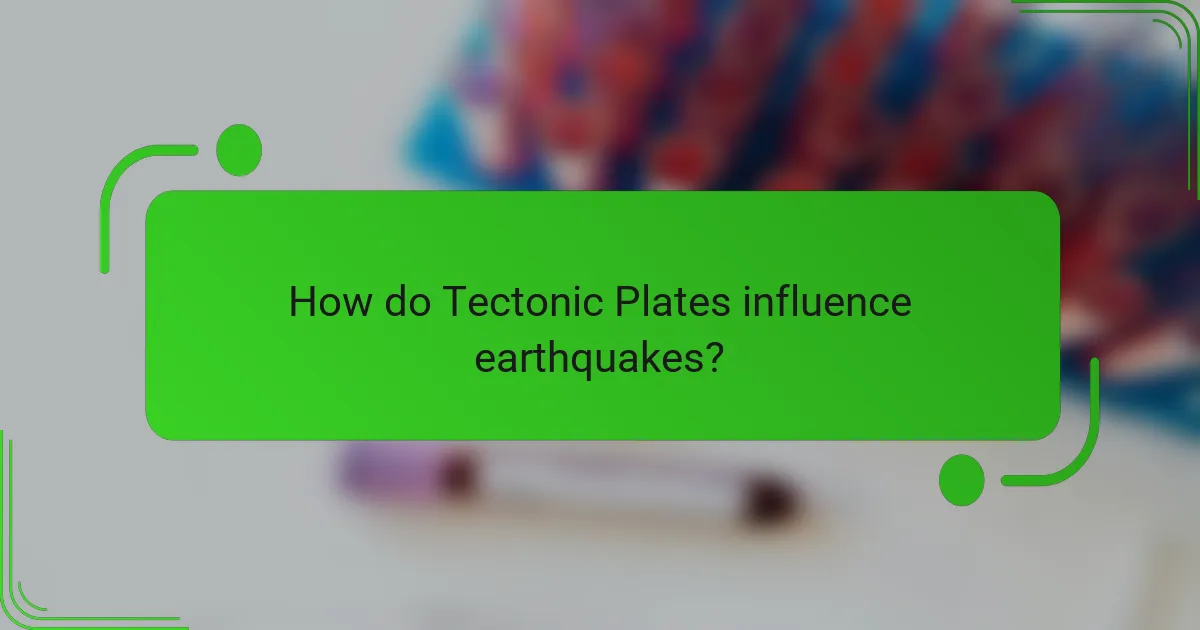
How do Tectonic Plates influence earthquakes?
Tectonic plates influence earthquakes through their movement and interactions at plate boundaries. These interactions can create stress in the Earth’s crust. When the stress exceeds the strength of rocks, it results in an earthquake. Most earthquakes occur along faults, which are fractures in the Earth’s crust where tectonic plates slide past each other. The three main types of plate boundaries are convergent, divergent, and transform. Convergent boundaries can cause subduction, leading to powerful earthquakes. Divergent boundaries involve plates moving apart, often resulting in smaller earthquakes. Transform boundaries, where plates slide horizontally, are also sites of significant seismic activity. Historical data shows that regions near tectonic plate boundaries are more seismically active. For example, the Pacific Ring of Fire is known for its high earthquake frequency due to numerous convergent and transform boundaries.
What is the relationship between Tectonic Plates and seismic activity?
Tectonic plates are large sections of the Earth’s lithosphere that move and interact at their boundaries. This movement causes seismic activity, which includes earthquakes. When tectonic plates collide, separate, or slide past each other, stress builds up in the Earth’s crust. Eventually, this stress is released, resulting in an earthquake. The majority of seismic activity occurs along plate boundaries, particularly at convergent and transform boundaries. Historical data shows that regions along these boundaries experience higher earthquake frequencies. For example, the Pacific Ring of Fire is known for its high seismic activity due to numerous tectonic plate interactions.
How do different plate boundaries contribute to earthquake occurrence?
Different plate boundaries contribute to earthquake occurrence through their distinct interactions. Divergent boundaries create earthquakes as tectonic plates move apart, causing tension and fracturing the crust. Convergent boundaries lead to earthquakes when one plate is forced beneath another, generating significant stress and potential for sudden release. Transform boundaries produce earthquakes as plates slide past each other, resulting in friction and strain accumulation. Historical data shows that regions along these boundaries, such as the San Andreas Fault, experience frequent seismic activity, confirming their role in earthquake generation.
What role does plate movement play in earthquake magnitude?
Plate movement is a primary factor in determining earthquake magnitude. When tectonic plates shift, they release energy that causes seismic waves. The magnitude of an earthquake correlates with the amount of energy released during this process. For instance, the moment magnitude scale quantifies this energy release. Subduction zones, where one plate moves under another, often produce larger earthquakes. Historical data shows that regions with active plate boundaries experience more significant seismic activity. The 2011 Tōhoku earthquake, resulting from plate movement, reached a magnitude of 9.0. This illustrates the direct link between plate movement and earthquake magnitude.
Why are some areas more prone to earthquakes than others?
Some areas are more prone to earthquakes due to their location along tectonic plate boundaries. Tectonic plates are large sections of the Earth’s crust that move and interact. When these plates collide, pull apart, or slide past each other, stress builds up. This stress is released as seismic energy, causing earthquakes. Regions like the Pacific Ring of Fire experience frequent seismic activity because they are situated along major plate boundaries. Historical data shows that over 90% of the world’s earthquakes occur in these zones.
How do historical earthquake patterns relate to Tectonic Plate boundaries?
Historical earthquake patterns are closely linked to tectonic plate boundaries. Most earthquakes occur along these boundaries due to the movement of tectonic plates. There are three main types of boundaries: convergent, divergent, and transform. Convergent boundaries often produce powerful earthquakes as plates collide. Divergent boundaries create earthquakes when plates pull apart. Transform boundaries generate earthquakes as plates slide past each other. Historical data shows that regions near these boundaries have higher seismic activity. For example, the Pacific Ring of Fire is known for frequent earthquakes due to its tectonic boundaries. This correlation between earthquake occurrence and plate boundaries is well-documented in geological studies.
What factors increase earthquake risk in certain regions?
Regions that experience increased earthquake risk are often located near tectonic plate boundaries. The movement of these plates can lead to stress accumulation and eventual release, causing earthquakes. Subduction zones, where one plate dives beneath another, are particularly prone to powerful quakes. Transform boundaries, where plates slide past each other, also generate significant seismic activity.
Additionally, geological factors such as fault lines, rock type, and soil composition can influence earthquake risk. Historical data shows that areas like California and Japan frequently experience earthquakes due to their location along major fault lines. Studies indicate that regions with a history of seismic activity are more likely to experience future earthquakes. For example, the San Andreas Fault in California has a long history of significant seismic events.

What can we learn from studying Tectonic Plates?
Studying tectonic plates teaches us about Earth’s geological processes. We learn how plates interact at boundaries, causing earthquakes and volcanic activity. For instance, the Pacific Plate and North American Plate interact along the San Andreas Fault, leading to significant seismic events. Understanding these movements helps predict earthquake risks in populated areas. Additionally, plate tectonics explains the formation of mountain ranges and ocean basins. The Himalayas, for example, formed from the collision of the Indian and Eurasian plates. Knowledge of tectonic activity informs infrastructure development and disaster preparedness. Overall, studying tectonic plates enhances our understanding of Earth’s dynamic nature and its impact on human life.
How can understanding Tectonic Plates help in earthquake preparedness?
Understanding tectonic plates is crucial for earthquake preparedness. Tectonic plates are large sections of the Earth’s crust that move and interact at their boundaries. These interactions can cause earthquakes, particularly at fault lines where stress accumulates. By studying plate boundaries, scientists can identify regions at higher risk for seismic activity. For instance, the Pacific Ring of Fire is known for its frequent earthquakes due to active plate boundaries. Knowing the location and movement of these plates allows communities to develop effective emergency plans. Preparedness measures can include building codes designed to withstand tremors. Historical earthquake data linked to tectonic activity also informs risk assessments. This understanding ultimately enhances public safety and resilience against potential earthquakes.
What measures can communities take to mitigate earthquake risks?
Communities can mitigate earthquake risks by implementing building codes that require seismic-resistant designs. These codes help ensure structures can withstand seismic forces. Regular drills and education programs increase public awareness of earthquake preparedness. Emergency response plans should be established to coordinate actions during an earthquake. Communities can also invest in early warning systems to alert residents before shaking begins. Retrofitting older buildings enhances their ability to endure earthquakes. Land-use planning can restrict development in high-risk zones. Community engagement fosters a culture of preparedness and resilience. Research indicates that these measures significantly reduce damage and enhance safety during seismic events.
How does education on Tectonic Plates contribute to public safety?
Education on tectonic plates enhances public safety by increasing awareness of earthquake risks. Understanding tectonic plate movement helps communities prepare for potential seismic events. This knowledge informs building codes and land-use planning. For instance, areas prone to earthquakes can implement stricter regulations. Educational programs can teach individuals how to respond during an earthquake. Training can include evacuation routes and emergency kit preparation. Studies show that educated populations experience fewer casualties during seismic events. For example, California’s earthquake preparedness initiatives have significantly reduced fatalities over the years.
What are the best practices for monitoring Tectonic Plate movements?
The best practices for monitoring tectonic plate movements include using GPS technology, seismic monitoring, and satellite imagery. GPS technology provides precise measurements of plate movements over time. Seismic monitoring detects earthquakes and helps analyze tectonic activity. Satellite imagery allows for the observation of surface deformation. Combining these methods enhances accuracy and provides comprehensive data. Continuous monitoring is essential for understanding tectonic behavior. Research shows that integrating multiple data sources improves predictions of seismic events. The US Geological Survey actively employs these practices to monitor tectonic activity effectively.
What technologies are used to track Tectonic Plate activity?
Global Positioning System (GPS) technology is used to track tectonic plate activity. GPS stations measure the precise movement of the Earth’s surface. These measurements provide data on the speed and direction of plate movements. InSAR, or Interferometric Synthetic Aperture Radar, is another technology used. It captures ground displacement over time through satellite imagery. Seismographs also play a crucial role in monitoring tectonic activity. They record the intensity and duration of seismic waves from earthquakes. Additionally, ocean buoys equipped with pressure sensors monitor changes in sea level caused by tectonic shifts. These technologies collectively enhance our understanding of tectonic plate dynamics.
How can data from Tectonic Plate studies inform construction practices?
Data from Tectonic Plate studies can significantly inform construction practices by identifying seismic hazards. Understanding plate boundaries helps engineers design buildings that can withstand earthquakes. For instance, regions near tectonic boundaries require flexible structures to absorb shock. Historical data on past earthquakes guides the selection of materials and construction techniques. Research shows that buildings designed with seismic considerations reduce damage during quakes. The 1994 Northridge earthquake highlighted the importance of such data in California’s building codes. Incorporating this knowledge leads to safer infrastructure and minimizes risks to human life.
Tectonic plates are large sections of the Earth’s lithosphere that move and interact at their boundaries, influencing geological phenomena such as earthquakes and volcanic activity. The article explores the formation, types, and movement patterns of tectonic plates, detailing the three main types of boundaries: divergent, convergent, and transform. It highlights how these interactions lead to significant geological features and seismic events, emphasizing the importance of understanding tectonic activity for earthquake preparedness and risk mitigation. Additionally, it discusses the technologies used to monitor tectonic movements and how data from these studies inform construction practices to enhance public safety.
